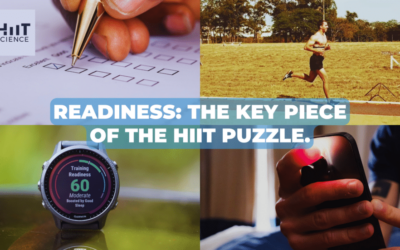Background
In Brazil, where I come from, there is an enormous demand for cycling coaching services, but relatively few coaches. This context enabled me to find my niche straight after finishing my degree in sports science. As a mountain biking coach since 2010, I have always been interested in exercise intensity prescription, training optimisation, and the methodological aspects of it.I was probably one of the first Brazilian coaches to convince my clients to purchase a power meter and that it was the best investment they could make to improve their performance.My interest in the methodological aspects of training never waned and ultimately led me down the road of an academic career. While I still coach a handful of athletes, I now consider myself more of a researcher than a coach. As I now approach the end of my PhD, I am keen to share with you a bit about what my research has found.
Introduction
The main physiological determinants of endurance exercise performance are the maximal oxygen uptake (V̇O2max), the maximal metabolic rate that can be sustained during long-duration exercise (as a fraction of V̇O2max), and the efficiency with which mechanical work is produced (8). As V̇O2max sets the upper limit for the aerobic metabolism, this indicator has long captured the attention of physiologists, coaches, and athletes.Often, the goal of training programmes is to stress the cardiorespiratory system to trigger adaptations that lead to performance gains by increasing V̇O2max.Not surprisingly, there is today a vast literature on the topic. In 1986, a comprehensive examination of the training literature, published by Wenger and Bell (15), showed that the magnitude of improvements in V̇O2max was associated with training intensity in the range of 50%–100%V̇O2max, irrespective of exercise frequency and duration. From that study, it became clear that training at 90%–100%V̇O2max elicited an optimal training stimulus (15), particularly in the case of well-trained athletes approaching the genetic limit for V̇O2max enhancement (11). Accordingly, in the late 1990s, Billat and colleagues conducted several studies to define the minimal work rate eliciting V̇O2max, the time to exhaustion when exercising continuously at that intensity, and the effective time spent at V̇O2max (see Billat and Koralsztein (2) for review). However, it was equally clear that intensities associated with V̇O2max cannot be sustained for long enough to produce a substantial training stimulus. This led Billat and colleagues to compare time spent at V̇O2max between continuous and intermittent exercises performed to exhaustion (4). As time spent at V̇O2max was superior for the intermittent exercise (4), this work prompted more investigations comparing different high-intensity interval training (HIIT) formats (6). While a range of definitions for time spent at V̇O2max have been used (9), more recently, time at >90%V̇O2max has become the norm for assessing the adaptive potential of specific HIIT sessions (6), perhaps due to its superior reliability (10). As professed in HIIT Science (Chapter 5), it is therefore of interest to characterise the training session formats that elicit the longest times at >90%V̇O2max, based on the assumption that this variable may represent a proxy of the adaptive stimulus (Figure 1).

Figure 1. Total exercise time and time spent at or near maximal oxygen uptake (T at VO2max) for typical HIIT formats: 2 × 2 min/1 min long intervals (LI), 1 × 8 min series of short intervals (15 s/15 s, SI), a repeated sprint sequence (RST, 2 sets of 6 sprints), a sprint interval session (SIT, 4 sprint repetitions), and an 8 min small-sided game (SGG, one of the most common forms of game-based HIIT, GBHIIT).
In our recent work with fourteen well-trained cyclists (mean V̇O2max of 69.2 ml·kg−1·min−1), we compared physiological and perceptual responses elicited by work intervals matched for duration and mean power output but differing in power-output distribution (5). Specifically, traditional constant-intensity work intervals were prescribed in one HIIT session, whereas power output was repeatedly varied within the work intervals of the other (see Figure 2).Our hypothesis was that higher fractions of V̇O2max would be sustained in the varied-intensity mode, which would, in turn, prolong time at >90%V̇O2max.Mechanistically, our hypothesis was based on an analogous study involving continuous exercise in which Billat and colleagues observed a longer time at >95%V̇O2max when power output was varied according to expired gas responses compared with exercise at a fixed work rate (3).
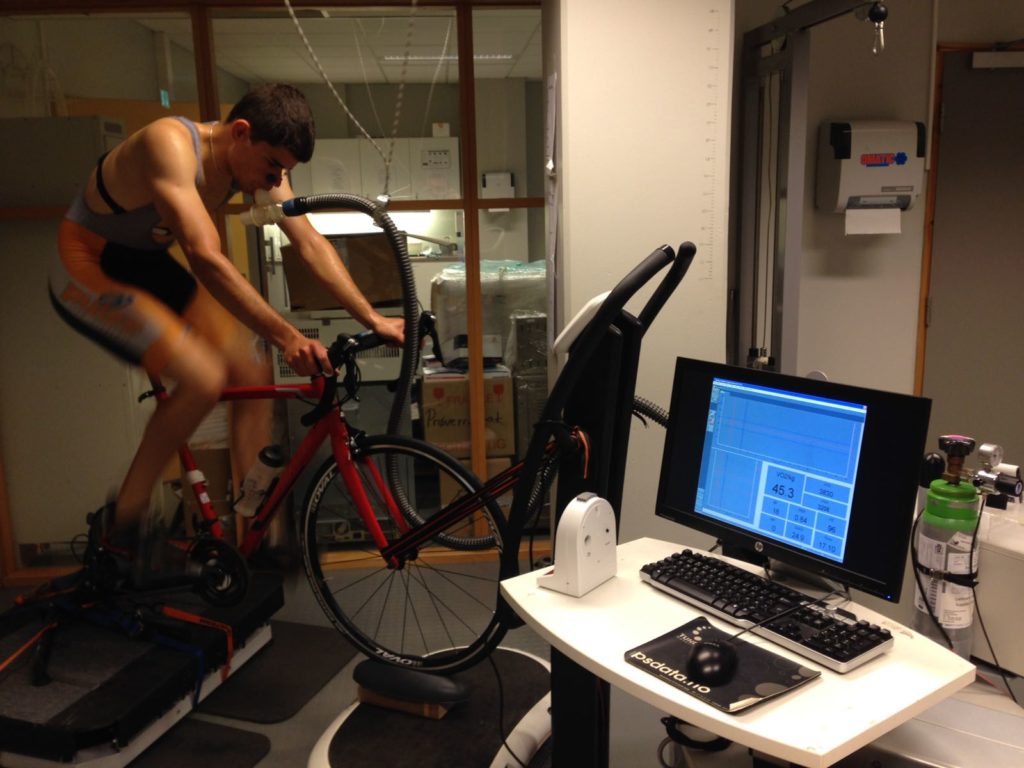
What did we do?
Cyclists attended the lab for a performance assessment and two HIIT sessions using either varied-intensity or constant-intensity work intervals. From the data of the initial session, we established participants’ V̇O2max and maximal aerobic power (MAP). MAP was calculated by extrapolating the relationship between submaximal power outputs and respective measures of V̇O2 to V̇O2max, by means of linear regression (7). HIIT sessions were performed on a smart trainer (KICKR, Wahoo Fitness, Atlanta, GA, USA) and exercise intensity was prescribed as %MAP (see Figure 2). The order of HIIT sessions was randomised. Expired gases were monitored during work intervals, heart rate throughout the sessions, and blood lactate concentration and ratings of perceived exertion after each work interval.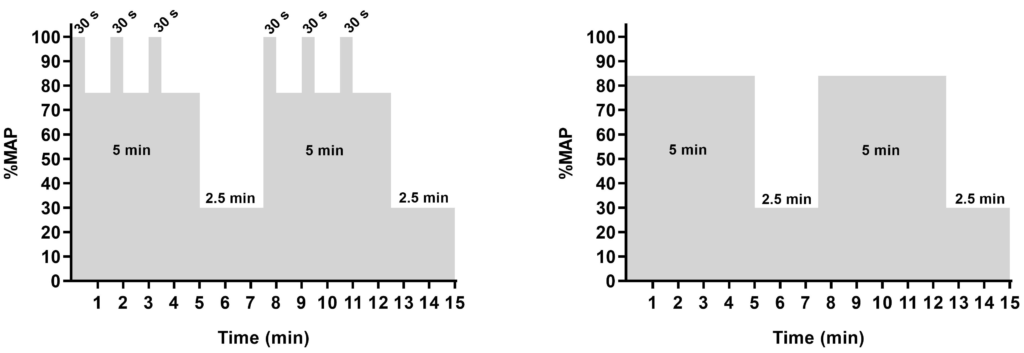 Figure 2. Varied-intensity work intervals consisted of three 30-s surges at 100%MAP, interspersed with two 1-min blocks and a final 1.5-min block, both at 77%MAP. Constant-intensity work intervals consisted of 5 min at 84%MAP. Six work intervals were completed for each session. MAP denotes maximal aerobic power (5).
Figure 2. Varied-intensity work intervals consisted of three 30-s surges at 100%MAP, interspersed with two 1-min blocks and a final 1.5-min block, both at 77%MAP. Constant-intensity work intervals consisted of 5 min at 84%MAP. Six work intervals were completed for each session. MAP denotes maximal aerobic power (5).
What did we find?
Confirming our hypothesis, cyclists spent on average 410 s at >90%V̇O2max, or 15.2% of the exercise duration (Exdur), during HIIT with varied-intensity work intervals compared to 286 s, or 10.6% Exdur, during HIIT with constant-intensity work intervals (an increase of 43%).However, there were no differences between sessions in heart rate, blood lactate concentration, or ratings of perceived exertion. Altogether, these results suggest that by varying the intensity within 5-min work intervals it is possible to stress the cardiorespiratory system to a greater extent than by performing constant-intensity work intervals. This study extends upon the findings of Billat et al. (3). As athletes’ heart rate, blood lactate concentration, and ratings of perceived exertion were not affected by the power distribution, there is a strong indication that fatigue did not increase in parallel with oxygen uptake.
In other words, this training strategy may provide athletes with more bang for the buck!
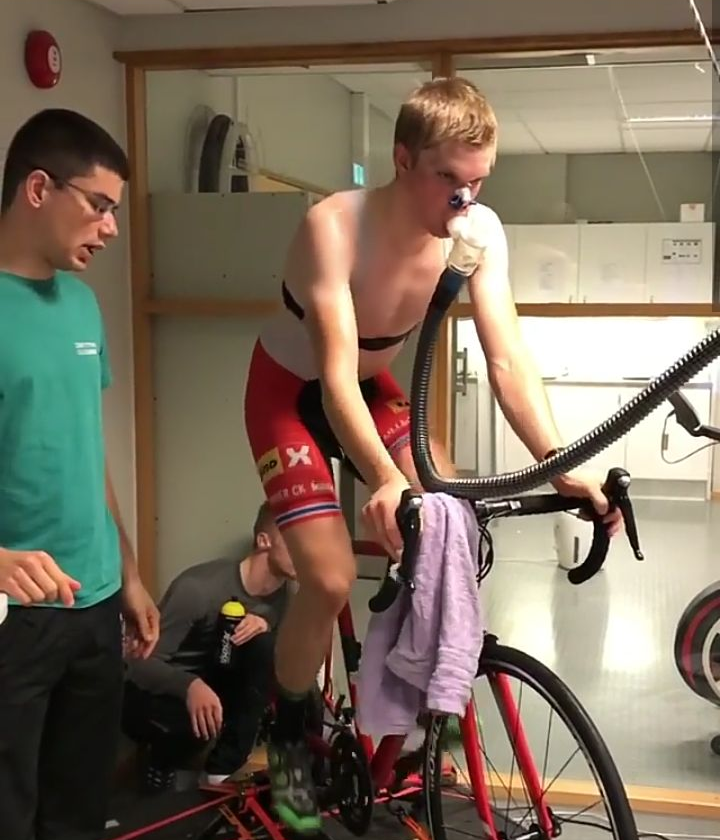 While the average times at >90%V̇O2max were not as high as the averages reported by Almquist et al. (1) (849 s or 37.7% Exdur, and 595 s or 33.1% Exdur) and Rønnestad et al. (14) (659 s or 24.4% Exdur, and 417 s or 15.4% Exdur), it is important to acknowledge that HIIT sessions were not performed to exhaustion in our study. Had cyclists performed work intervals to exhaustion, as in the aforementioned studies (1, 14), chances are that time at >90%V̇O2max would have been much greater. But as emphasized always in HIIT Science, performing HIIT to exhaustion has never been the intent of the practice, and we should do away with the ‘no pain, no gain adage’. Indeed, coaches and athletes should use the scientific principles, but always leave a HIIT session as if they could do 1 or 2 more work intervals.
While the average times at >90%V̇O2max were not as high as the averages reported by Almquist et al. (1) (849 s or 37.7% Exdur, and 595 s or 33.1% Exdur) and Rønnestad et al. (14) (659 s or 24.4% Exdur, and 417 s or 15.4% Exdur), it is important to acknowledge that HIIT sessions were not performed to exhaustion in our study. Had cyclists performed work intervals to exhaustion, as in the aforementioned studies (1, 14), chances are that time at >90%V̇O2max would have been much greater. But as emphasized always in HIIT Science, performing HIIT to exhaustion has never been the intent of the practice, and we should do away with the ‘no pain, no gain adage’. Indeed, coaches and athletes should use the scientific principles, but always leave a HIIT session as if they could do 1 or 2 more work intervals.
 Figure 3. a) Time spent over 90% of V̇O2max, (b) sRPE, and (c) individualized training impulse (iTRIMP). Open circles represent each participant, and black squares represent the mean values for HIIT sessions with varied-intensity and constant intensity work intervals (WI). sRPE indicates session rating of perceived exertion; V̇O2max, maximal oxygen uptake. *Different from constant WI.
Figure 3. a) Time spent over 90% of V̇O2max, (b) sRPE, and (c) individualized training impulse (iTRIMP). Open circles represent each participant, and black squares represent the mean values for HIIT sessions with varied-intensity and constant intensity work intervals (WI). sRPE indicates session rating of perceived exertion; V̇O2max, maximal oxygen uptake. *Different from constant WI.
How could you apply this in practice?
Since the publication of our study, several people have asked me about practical ways of implementing these varied-intensity work intervals. One idea I had was to perform the varied-intensity work intervals as a maximal-performance, self-paced HIIT session.Our results suggest that sticking to only one power output is unnecessary, if not counter-productive.Instead of providing athletes with power output targets, coaches can instruct them to identify the maximal sustainable work rates for the entire training session. As long as work intervals are reasonably similar, and ratings of perceived exertion at the end of each bout increases approximately linearly towards maximal, coaches should be successful in employing the session without the need for laborious MAP estimations. For example, Swedish sports science student Viktor Engman has proposed that the intensity of each block within the work intervals should be described as a percentage of perceived effort. The 30-s surges would be performed at the maximal effort sustainable for the 18 surges of this HIIT session, whereas the remainder of the work interval would be performed at 80% of that effort. Figure 4 shows the average power output distribution of three cyclists that successfully implemented this approach for the varied-intensity work intervals on their home trainers.
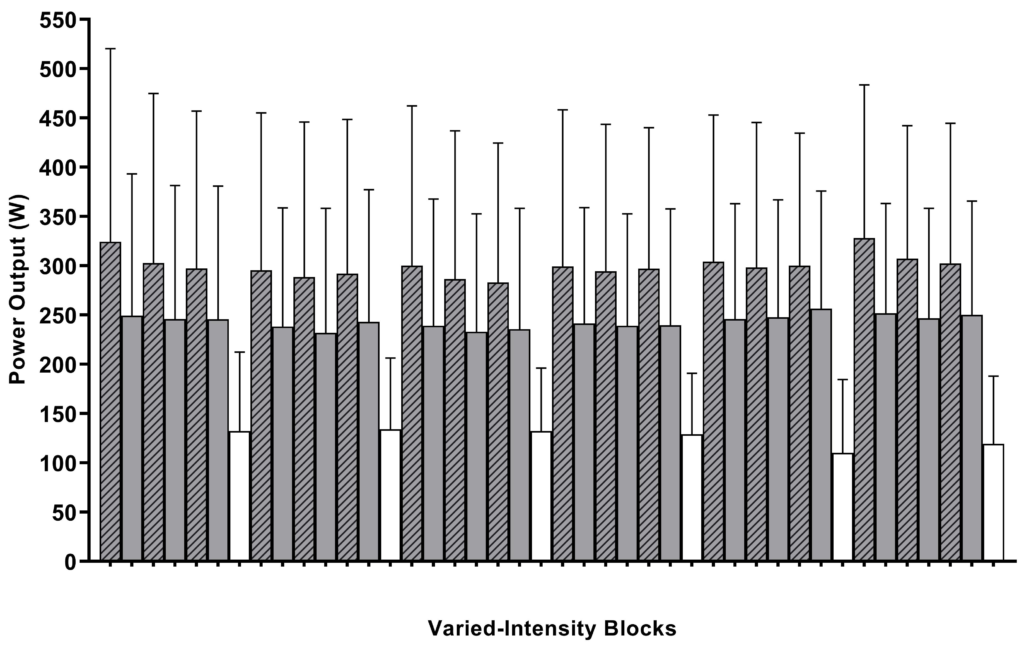 Figure 4. Power output distribution of three cyclists of different performance levels (two men and one woman) that successfully performed a HIIT session with varied-intensity work intervals based on perceived effort. The 30-s surges (striped bars) should be performed at the maximal effort sustainable for the 18 surges of this HIIT session, whereas the remainder of the work interval (solid grey bars) should be performed at 80% of that effort (Engman, 2020; personal communication). Solid white bars represent active-recovery periods.
Recently, it has been shown that short work intervals (30 s) interspersed with short recovery periods (15 s) produce a longer time at >90%V̇O2max (1) and more training adaptations (12, 13) than long work intervals (5 min) interspersed with long recovery periods (2.5 min). However, coaches should not neglect the specificity of sustained high-intensity efforts for optimal racing performance. Accordingly, the varied-intensity work intervals may be an effective strategy to combine the training benefits of both short and longer work intervals. Although further research is necessary to confirm this hypothesis, coaches are encouraged to try the varied-intensity work intervals as an alternative paradigm for HIIT prescription. The results of our study are encouraging and suggest negative training outcomes are unlikely to occur.
Figure 4. Power output distribution of three cyclists of different performance levels (two men and one woman) that successfully performed a HIIT session with varied-intensity work intervals based on perceived effort. The 30-s surges (striped bars) should be performed at the maximal effort sustainable for the 18 surges of this HIIT session, whereas the remainder of the work interval (solid grey bars) should be performed at 80% of that effort (Engman, 2020; personal communication). Solid white bars represent active-recovery periods.
Recently, it has been shown that short work intervals (30 s) interspersed with short recovery periods (15 s) produce a longer time at >90%V̇O2max (1) and more training adaptations (12, 13) than long work intervals (5 min) interspersed with long recovery periods (2.5 min). However, coaches should not neglect the specificity of sustained high-intensity efforts for optimal racing performance. Accordingly, the varied-intensity work intervals may be an effective strategy to combine the training benefits of both short and longer work intervals. Although further research is necessary to confirm this hypothesis, coaches are encouraged to try the varied-intensity work intervals as an alternative paradigm for HIIT prescription. The results of our study are encouraging and suggest negative training outcomes are unlikely to occur.
In summary, varied-intensity work intervals increased time at >90%V̇O2max during HIIT compared with constant-intensity long work intervals.This increased demand on the cardiorespiratory system was not accompanied by higher heart rates, blood lactate concentrations, or ratings of perceived exertion, implying further optimization of the aerobic training stimulus. There was also anecdotal evidence that athletes can pace their efforts successfully based on perceived effort instructions, providing an easy-to-implement approach for training intensity individualisation. The latter approach should be tested in future research.
About the author
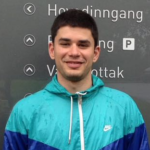 Arthur Henrique Bossi is a sports scientist, currently at the University of Kent, where he is writing his PhD thesis on the optimisation of exercise intensity prescription to reduce adaptation variability following HIIT. He loves mountain biking and all things related to training prescription and exercise physiology. You can follow him on Twitter @ahbossi.
Arthur Henrique Bossi is a sports scientist, currently at the University of Kent, where he is writing his PhD thesis on the optimisation of exercise intensity prescription to reduce adaptation variability following HIIT. He loves mountain biking and all things related to training prescription and exercise physiology. You can follow him on Twitter @ahbossi.
References
- Almquist NW, Nygaard H, Vegge G, Hammarström D, Ellefsen S, and Rønnestad BR. Systemic and muscular responses to effort-matched short intervals and long intervals in elite cyclists. Scandinavian Journal of Medicine and Science in Sports 30: 1140-1150, 2020.
- Billat LV and Koralsztein JP. Significance of the velocity at V̇O2max and time to exhaustion at this velocity. Sports Medicine 22: 90-108, 1996.
- Billat V, Petot H, Karp JR, Sarre G, Morton RH, and Mille-Hamard L. The sustainability of V̇O2max: effect of decreasing the workload. European Journal of Applied Physiology 113: 385-394, 2013.
- Billat VL, Slawinski J, Bocquet V, Demarle A, Lafitte L, Chassaing P, and Koralsztein JP. Intermittent runs at the velocity associated with maximal oxygen uptake enables subjects to remain at maximal oxygen uptake for a longer time than intense but submaximal runs. European Journal of Applied Physiology 81: 188-196, 2000.
- Bossi AH, Mesquida C, Passfield L, Rønnestad BR, and Hopker JG. Optimizing interval training through power-output variation within the work intervals. International Journal of Sports Physiology and Performance 15: 982-989, 2020.
- Buchheit M and Laursen PB. High-intensity interval training, solutions to the programming puzzle: Part I: cardiopulmonary emphasis. Sports Medicine 43: 313-338, 2013.
- Daniels JT. A physiologist’s view of running economy. Medicine and Science in Sports and Exercise 17: 332-338, 1985.
- Joyner MJ and Coyle EF. Endurance exercise performance: the physiology of champions. Journal of Physiology 586: 35-44, 2008.
- Midgley AW, Mc Naughton LR, and Wilkinson M. Criteria and other methodological considerations in the evaluation of time at V̇O2max. Journal of Sports Medicine and Physical Fitness 46: 183-188, 2006.
- Midgley AW, McNaughton LR, and Carroll S. Reproducibility of time at or near VO2max during intermittent treadmill running. International Journal of Sports Medicine 28: 40-47, 2007.
- Midgley AW, McNaughton LR, and Wilkinson M. Is there an optimal training intensity for enhancing the maximal oxygen uptake of distance runners? Empirical research findings, current opinions, physiological rationale and practical recommendations. Sports Medicine 36: 117-132, 2006.
- Rønnestad BR, Hansen J, Nygaard H, and Lundby C. Superior performance improvements in elite cyclists following short-interval vs effort-matched long-interval training. Scandinavian Journal of Medicine and Science in Sports, 2020.
- Rønnestad BR, Hansen J, Vegge G, Tonnessen E, and Slettalokken G. Short intervals induce superior training adaptations compared with long intervals in cyclists – an effort-matched approach. Scandinavian Journal of Medicine and Science in Sports 25: 143-151, 2015.
- Rønnestad BR, Moen M, Gunnerød S, and Øfsteng S. Adding vibration to high-intensity intervals increase time at high oxygen uptake in well-trained cyclists. Scandinavian Journal of Medicine and Science in Sports 28: 2473-2480, 2018.
- Wenger HA and Bell GJ. The interactions of intensity, frequency and duration of exercise training in altering cardiorespiratory fitness. Sports Medicine 3: 346-356, 1986.



